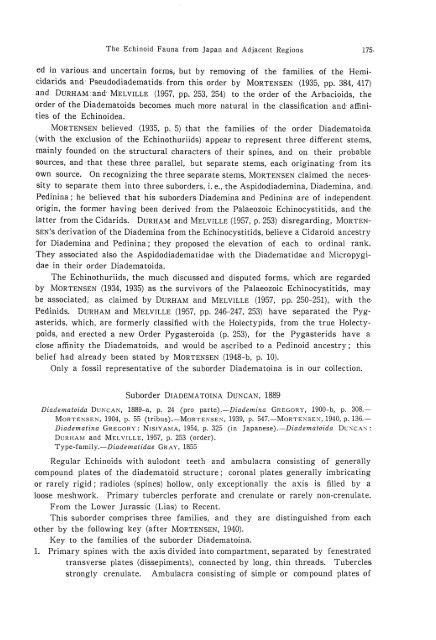the echinoid fauna from japan and adjacent regions part i
the echinoid fauna from japan and adjacent regions part i
the echinoid fauna from japan and adjacent regions part i
You also want an ePaper? Increase the reach of your titles
YUMPU automatically turns print PDFs into web optimized ePapers that Google loves.
The Echinoid Fauna <strong>from</strong> Japan <strong>and</strong> Adjacent Regions<br />
ed in various <strong>and</strong> uncertain forms; but by removing of <strong>the</strong> families of <strong>the</strong> Hemicidarids<br />
<strong>and</strong>' Pseudodiadematids <strong>from</strong> this order by MORTENSEN (1935, pp. 384, 417)<br />
<strong>and</strong>, DURHAM: <strong>and</strong>' MELVILLE. (1957, pp. 253, 254) to <strong>the</strong> order of <strong>the</strong> Arbacioids, <strong>the</strong><br />
order of <strong>the</strong> Diadematoids becomes much more natural in <strong>the</strong> classification <strong>and</strong>: affinities<br />
of <strong>the</strong> Echinoidea.<br />
MORTENSEN believed (1935, p. 5) that <strong>the</strong>, families of <strong>the</strong> order Diadematoida<br />
(with <strong>the</strong> exclusion of <strong>the</strong> Echinothuriids) appear to represent three different stems,<br />
mainly founded on <strong>the</strong>, structural characters of <strong>the</strong>ir spines, <strong>and</strong> on <strong>the</strong>ir probable<br />
sources. <strong>and</strong>, that <strong>the</strong>se three parallel, but separate stems, each originating <strong>from</strong> its.<br />
own source. On recognizing <strong>the</strong> three separate stems, MORTENSEN claimed <strong>the</strong>, necessity<br />
to separate <strong>the</strong>m into three suborders; i. e., <strong>the</strong> Aspidodiademina, Diademina, <strong>and</strong>:<br />
Pedinina; he believed that his suborders Diademina <strong>and</strong> Pedinina, are of independent<br />
origin, <strong>the</strong> former having been derived <strong>from</strong> <strong>the</strong> Palaeozoic Echinocystitids, <strong>and</strong> <strong>the</strong>,<br />
latter <strong>from</strong> <strong>the</strong> Cidarids. DURHAM <strong>and</strong> MELVILLE (1957, p. 253) disregarding, MORTEN<br />
SEN'S derivation of <strong>the</strong> Diademina <strong>from</strong> <strong>the</strong> Echinocystitids, believe a Cidaroid ancestry<br />
for Diademina <strong>and</strong> Pedinina; <strong>the</strong>y proposed <strong>the</strong> e-levation of each to ordinal rank.<br />
They associated also <strong>the</strong> Aspidodiadematidae with <strong>the</strong> Diadematidae <strong>and</strong> Micropygidae<br />
in <strong>the</strong>ir order Diadematoida.<br />
The Echinothuriids; <strong>the</strong> much discussed <strong>and</strong> disputed forms, which are regarded<br />
by MORTENSEN (1934, 1935) as <strong>the</strong> survivors of <strong>the</strong> Palaeozoic Echinocystitids, may<br />
be associated; as claimed by DURHAM <strong>and</strong> MELVILLE (1957, pp. 250-251), with <strong>the</strong>·<br />
Pedinids. DURHAM <strong>and</strong> MELVILLE (1957, pp. 246-247, 253) have separated <strong>the</strong> Pygasterids,<br />
which, are formerly classified with <strong>the</strong> Holectypids, <strong>from</strong> <strong>the</strong> true Holectypoids,<br />
<strong>and</strong> erected a new Order Pygasteroida (p. 253), for <strong>the</strong> Pygasterids have a<br />
close affinity <strong>the</strong> Diadematoids, <strong>and</strong> would be ascribed to a Pedinoid ancestry; this.<br />
belief had already been stated by MORTENSEN (1948-b, p. 10).<br />
Only a fossil representative of <strong>the</strong> suborder Diadematoina is in our collection.<br />
Suborder DIADEMA TOlNA DUNCAN, 1889<br />
Diadematoida DUKCAN, 1889-a, p. 24 (pro <strong>part</strong>e).-Diademina GREGORY, 1900-b, p, 308.<br />
MORTEKSEN, 1904, p. 55 (tribus).-MoRTENSEN, 1939, p. 547.-MoRTENSEN, 1940, p. 136,<br />
Diadematina GREGORY: NISIYAIVIA, 1954, p. 325 (in Japanese).-Diadematoida Dc:\cA:\:<br />
DURHAlvl <strong>and</strong> MELVILLE, 1957, p. 253 (order).<br />
Type-family.-Diadematidae GRAY, 1855<br />
Regular Echinoids with aulodont teeth <strong>and</strong> ambulacra consisting of generally<br />
compound, plates of <strong>the</strong> diadematoid structure; coronal plates generally imbricating<br />
or rarely rigid; radioles (spines) hollow, only exceptionally <strong>the</strong> axis is filled by a<br />
loose meshwork. Primary tubercles perforate <strong>and</strong> crenulate or rarely non-crenulate.<br />
From <strong>the</strong> Lower Jurassic (Lias) to Recent.<br />
This suborder comprises three families, <strong>and</strong> <strong>the</strong>y are distinguished <strong>from</strong> each<br />
o<strong>the</strong>r by <strong>the</strong> following key (after MORTENSEN, 1940).<br />
Key to <strong>the</strong> families of <strong>the</strong> suborder Diadematoina.<br />
1. Primary spines with <strong>the</strong> axis divided into com<strong>part</strong>ment, separated by fenestrated<br />
transverse plates (dissepiments), connected by long, thin threads. Tubercles<br />
strongly crenulate. Ambulacra consisting of simple or compound plates of












